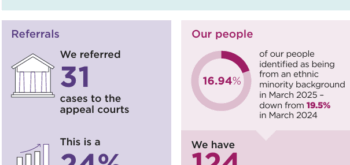Dr Andrew Green argues that the rules of evidence relating to computer produced material have been ‘misrepresented in a way that intimidates defendants’ and material relating to the Horizon computer system and Fujitsu’s role in selling a defective system have been concealed in secret court hearings where Post Office lawyers argued that it would not be in the public interest to disclose it.
The subpostmasters who are the victims of the most extensive miscarriage of justice that has ever happened in the UK criminal justice system, blame in part the law relating to the admissibility of computer generated evidence. In 1984 the Police and Criminal Evidence Act (PACE) introduced strict rules to be followed which authenticated the accuracy of such evidence, before it could be put to a court in a trial. Section 69(1)(a) required ‘that there are no reasonable grounds for believing that the statement is inaccurate because of improper use of the computer’ and section 69(1)(b) required ‘that at all material times the computer was operating properly.’
In 1999 these provisions were repealed. Reports in the media stated a presumption was introduced into law on how courts should consider electronic evidence. The new rule introduced in 1999 followed a Law Commission recommendation for courts to presume that a computer system has operated correctly unless there is explicit evidence to the contrary (Karl Flinders, Computer Weekly, 20 January 2021).
Alex Hern, writing in the Guardian (12 January 2024), quoted Stephen Mason, a barrister and expert on electronic evidence, who said: ‘It says, for the person who’s saying “there’s something wrong with this computer”, that they have to prove it. Even if it’s the person accusing them who has the information.’ Is this a correct interpretation of the law? The Crown Prosecution Service’s online legal guidance (always an authoritative and useful source) states that since the 1999 change in the law, computer evidence must follow the common law rule, that a presumption will exist that the computer producing the evidential record was working properly at the material time and that the record is therefore admissible as real evidence.
Just like any other evidence that is not subject to special admissibility rules. But common law admissibility rules include rebuttal provisions, the CPS reminds us. That presumption can, however, be rebutted if evidence to the contrary is adduced (the ‘rebuttable presumption’). In that event it will be for the party seeking to produce the computer record in evidence to satisfy the court that the computer was working properly at the material time (for detailed guidance as to the law, see Archbold 9-11 9-15).
In other words, if computer generated material is introduced in criminal proceedings by the prosecution, the defence is entitled to adduce evidence showing that the material is demonstrably different from normal material routinely produced in similar circumstances, and that there is no evidence to support the accuracy of the computer generated material (such as records of individual transactions). Defendants (all of them of good character) were entitled to rebut allegations of fraud or false accounting when giving evidence in a trial.
According to the CPS’s Disclosure Manual, material should normally be disclosed if it is relevant to
the nature of the case against the accused,
- the essential elements of the offence alleged,
- the evidence upon which the prosecution relies, and
- any explanation offered by the accused [rebuttal], whether in formal interview or otherwise.
And so ‘the party seeking to produce the computer record in evidence’ would need ‘to satisfy the court that the computer was working properly.’ Not the defendant. The burden of proof should not have been reversed. The law does not privilege computer generated evidence over other kinds of evidence. For example, if a person is prosecuted for committing a violent crime on the basis of identification evidence, they are entitled to require proof that CCTV equipment was functioning properly, that they really are the person shown in images, that eyewitnesses have not made a mistake, and so on.
The change in the law relating to computer generated evidence made it easier for the Post Office to mount prosecutions against subpostmasters, but it did not change common law evidence rules. Making a certain type of prosecution evidence admissible is not the same as proving its authenticity and accuracy.
So, what went wrong? Why did lawyers acting for these defendants fail to mount successful challenges to what are now accepted (universally, it appears) to be completely false allegations and gross injustices? Why was evidence which could have been challenged, not challenged? Why are the lawyers so silent on this issue?
When Computer Weekly claimed ‘IT scandal exposes legal rule that made it easy for Post Office to prosecute the innocent’, they were right – it was easier to start a prosecution, because the correct functioning of the computer did not have to be proved in order to charge a suspect on the basis of the computer generated evidence. But they did have to come up with proof that the system concerned was operating properly.
So were reporters and lawyers pointing the finger at the rules that really were to blame – or do other rules exist, far more disturbing rules which hide such abuses? And so permit and encourage unjust prosecutions?
Disclosure basics
When the police investigate a case, they are legally required to follow up all reasonable lines of inquiry, whether they point to, or away from, the guilt of a suspect. Any evidence they have or obtain (called material) which points towards the innocence of a suspect, or which undermines the prosecution case, in all normal circumstances, must be disclosed to a suspect when they are charged with a crime and become a defendant, and at any time until criminal proceedings are completed.
The disclosure officer should:
- copy that material to the prosecutor to include:
- material which in the opinion of the disclosure officer satisfies the disclosure test (para 7.3 & 7.4 of the Code)…
- any material which falls within the categories for the rebuttable presumption (para 7.5 of the Code), and;
- allow the prosecutor to inspect material.
Certifications by the disclosure officer
The OIC must ensure that all relevant material that has been retained is either revealed to the disclosure officer, or in exceptional circumstances, revealed on a highly sensitive schedule directly to the prosecutor.
The disclosure officer must provide different certifications in the course of the disclosure process, to cover:
- revelation of all relevant retained material;
- confirmation that no material falls within the categories to which the rebuttable presumption applies (if appropriate);
- whether material satisfies the disclosure test; and
- whether material satisfies the disclosure test following a defence statement as part of continuing duty.
The actual disclosure procedure is complex. In practice it is wholly under the control of the prosecutors. Part of that procedure can include granting public interest immunity to some of material is a secret part of the disclosure procedure, which is used in some cases. How often is this procedure used? We don’t know. It’s secret. (See the note below on the standard police disclosure duties. Although the Post Office prosecutions were private prosecutions, disclosure requirements are the same as those that apply to the police and the CPS – all Post Office investigators had previously been police officers and knew what the criminal justice system rules and procedures were.)
Public Interest Immunity (PII)
The rules governing the granting of PII to evidence, which can have the effect of hiding the evidential material concerned and excluding it from trials, are contained in the Criminal Procedure Rules (CPR; the most recent 2020 version is cited here. PII acquired legislative status in the Criminal Procedure and Investigations Act 1996).
The Criminal Procedure Rules have the status of secondary legislation, the next best thing to statutes, which are debated and voted on in parliament. Any updates are laid before parliament for members to inspect and comment on. They are published in full online. Readers not yet familiar with this law may like to know:
1.1.—(1) The overriding objective of this procedural code is that criminal cases be dealt with justly.
(2) Dealing with a criminal case justly includes―
(a) acquitting the innocent and convicting the guilty;
(b) dealing with the prosecution and the defence fairly;
(c) recognising the rights of a defendant, particularly those under Article 6 of the European Convention on Human Rights.
So far so good. CPR section 15.3 covers the procedure for granting PII to evidence.
This rule applies where, without a court order, the prosecutor would have to disclose material; and the prosecutor wants the court to decide whether it would be in the public interest to disclose it.
‘Having to disclose material’ refers to material which would benefit the defence and so should be disclosed under the normal disclosure rules. This procedure is used when the prosecution does not want the defence to know about this material, because then it would become known to the public. The prosecution wants the court to rule that the prosecution does not have to disclose the material in question.
The application for PII to be granted to an item of evidence is decided at a hearing which must be in private (unless the court otherwise directs) and (if the court so directs) may take place, wholly or in part, in the defendant’s absence.
Unless the court otherwise directs, the court officer must not give notice to anyone other than the prosecutor of the hearing of an application under this rule … or of the court’s decision on the application.
To summarise: PII may be granted to material held by the prosecution, and which would benefit the defence case, without the defence knowing anything about it – not knowing that the material exists, not knowing that a court hearing about it has taken place, not being able to challenge the ruling; that is, in complete secrecy. The judge presiding over a PII hearing must make their decision entirely on the evidence supplied by the prosecution. They can take defence statements into account, but in stating their defendants’ cases, defence lawyers have no knowledge of the secret evidence to be put before a court hearing a PII application, or of the possibility that a PII hearing might be held. Prosecutors and investigators are free to tell judges anything they like, without fear of contradiction. They could assure judges that the Horizon program is ‘robust’ – a word which appears to be a synonym for infallible in their usage – that it’s tried and tested and reviewed, and that there is no access to the data it holds by Post Office or Fujitsu staff.
A record of the hearing and the decision is kept in a securely locked cupboard somewhere in the court building. Where? Well, that’s a secret. Who can see the record? We don’t know. But the Court of Appeal Criminal Division (CACD) can see it – as long as the court follows the PII rules.
Since the secrecy of a PII hearing and everything about it is determined by a court, any breach of the secrecy rules may constitute a contempt of court, which is subject to severe sanctions. Who is subject to the rules of the court? The CPR says: ‘[a]nyone involved in any way with a criminal case is a participant in its conduct…’. So that includes the defence lawyers and the defendants themselves. But not the rest of us.
What sort of material is subject to PII rulings? The Code of Practice issued under the Criminal Procedure and Investigations Act 1996 (section 23(1)) 2021 edition states:
‘[A]ny material the disclosure of which [prosecutors] believe would give rise to a real risk of serious prejudice to an important public interest, and the reason for that belief.
This ‘sensitive material’ typically includes ‘material relating to national security, … the identity or activities of informants, or undercover police officers, or witnesses, or other persons supplying information to the police who may be in danger if their identities are revealed.’
But other categories exist which would directly cover Horizon material. Material revealing, either directly or indirectly, techniques and methods relied upon by a police officer in the course of a criminal investigation. Under this heading could be included how they gathered and analysed (or failed to analyse) Horizon material.
Material whose disclosure might facilitate the commission of other offences or hinder the prevention and detection of crime.
If this subpostmasters knew precisely how Horizon worked, they might use such knowledge in order to commit crimes or hide the crimes they were already committing, in the view of the Post Office and its investigators. If our suppositions are correct, and a PII ruling was indeed obtained, then this would probably be the main reason for it.
Another reason for not disclosing Horizon material is likely to have been commercial confidentiality (worth a lot to Fujitsu, who were being paid a lot for the computer system and its maintenance, and who stood to lose contracts if their incompetence was exposed. The government was also heavily committed to using Fujitsu computerised system, and that would have been seen as giving ‘rise to a real risk of serious prejudice to an important public interest.’ The UK state was concerned at the highest level (Prime Minister Tony Blair) that Horizon should be brought into use, and paid very large sums to Fujitsu. (See also Rowena Mason and Russell Scott, ‘Kemi Badenoch failed to raise Horizon scandal when she met Fujitsu at Davos,’ Observer 11 February 2024: ‘Exclusive: FoI request shows [Business Secretary] was warned by civil servants of “risk” but focused instead on tech firm’s investment in UK.’)
But the CPR also state that
The court may only determine [i.e. grant] the application if it is satisfied that it has been able to take adequate account of … the defendant’s right to a fair trial.
Could defendants have a fair trial without disclosure of Horizon material? The judges would have ruled that a fair trial would be possible because the Horizon material would add nothing to the defence case, because they had been firmly reassured that Horizon is ‘robust’. The prosecution would have introduced the argument that it was the defence’s responsibility to prove otherwise, and the defence had not produced any evidence to show that Horizon had major and relevant faults. The defence was excluded from PII hearings, so they were not able to argue against this claim. Hence the widespread acceptance of this view, and the repeated refusal of the Post Office to disclose Horizon material.
How we can deduce that PII hearings have taken place?
- 1. The logic of the Post Office argument – that many subpostmasters are dishonest – would mean that to disclose detailed information about the working of Horizon would facilitate the commission of crimes in future, which might be made harder to detect. A PII ruling would prevent fraud and theft, Post Office lawyers would have argued.
- 2. If Horizon was appearing to expose fraud and theft, then it would remain a valuable system. A PII ruling would protect a valuable asset belonging to Fujitsu, to the UK state and its relationship with Japan.
- 3. Judges trying the Post Office cases appear to have confidence in the ‘robustness’ (or infallibility) of Horizon than has been stated in open court – a matter on which they could be reassured without fear of defence challenges which could have been made in open court.
- 4. If judges trying these cases appear to know more about individual defendants (eg for sentencing purposes) than has been stated in open court or agreed evidence, then this is attributable to information given in the absence of defendants, such as a PII hearing (analysis of sentencing remarks would be necessary in order to confirm this proposition).
- 5. Defence lawyers appear to have been generally silent about the issues concerning non-disclosure of material which is subject to PII, indicating they are bound by the secrecy required by the PII procedure.
- 6. The Court of Appeal could probably cope with the burden of overturning the wrongful convictions, given the similar nature of all the cases and the collapse of the prosecution. But appeal procedures might expose how PII hearings were abused to cover up Horizon system defects and failures to remedy them. The proposed exceptional legislation would remove the exposure of embarrassments to the state, the Post Office and Fujitsu. It would remove the legal problem which would be caused by appeal courts being forced to admit evidence which had been concealed by other courts. No doubt the legislative solution would adopt the ‘faulty program’ explanation, thus foreclosing investigation of other explanations, such as the tampering with Horizon data featured in the ITV drama, which was factual, not fictional.
- 7. Perhaps most importantly, many (possibly all) suspects raised issues concerning Horizon as part of their defences. These were rational explanations in terms of obvious system defects and possible manipulations of data by the staff at the Post Office and Fujitsu who had access to Horizon data, and opportunities to change it. In an investigation following the rules laid down in the CPIA 1996 and its associated Code of Practice, these explanations constituted reasonable lines of inquiry, which investigators were legally obliged to follow. The Post Office’s own investigators were former police officers who were aware of the responsibilities of criminal investigators.
Either the private investigators did not bother to investigate defences that were put to them, or they followed the Code of Practice and did investigate in response to suspects’ rebuttal evidence. In the latter case, they would have obtained relevant material which should have been disclosed to defendants, but were absolved from their disclosure duties by PII rulings.
The Disclosure Officer’s Report MG6E
Refreshed: 21 October 2021|Legal Guidance. Form MG6E is a standard form completed by police investigators in preparation for all criminal prosecutions. The completed forms are sent to CPS prosecutors. The following text is on the CPS web site, but all emphases have been added.
The disclosure officer should use the MG6E to bring to the prosecutor’s attention any material that could reasonably be considered capable of undermining the prosecution case against the accused or of assisting the case for the accused. This also applies to sensitive material.
The disclosure officer should also explain on form MG6E (by referring to the relevant item’s number on the schedule) why he or she has come to that view. The MG6E schedule should be completed in accordance with the National Standards of Disclosure.
Any material that supports or is consistent with a defence put forward in interview or before charge or which is apparent from the prosecution papers, should be included. It also includes anything that points away from the accused, such as information about a possible alibi. Items of material viewed in isolation may not satisfy the test; however, several items together can have that effect. In applying the disclosure test, disclosure officers and prosecutors should not be judgmental about the merits of a defence and any doubt should be resolved in favour of disclosure.
… The disclosure officer should consult with the prosecutor where necessary to help identify material that may require disclosure, and must specifically draw material to the attention of the prosecutor where the disclosure officer has any doubt as to whether it might satisfy the disclosure test.…
[Material classed as ‘sensitive’ and which could be considered as needing Public Interest Immunity]
To assist the prosecutor to decide how to deal with sensitive material which the investigator believes may meet the disclosure test, the investigator should provide detailed information dealing with the following issues:
- the reasons why the material is said to be sensitive;
- the degree of sensitivity said to attach to the material, in other words, why it is considered that disclosure will create a real risk of serious prejudice to an important public interest;
- the consequences of revealing to the defence7
1. the material itself
2. the category of the material
3. the fact that an application may be made
- the apparent significance of the material to the issues in the trial;
- the involvement of any third parties in bringing the material to the attention of the police;
- where the material is likely to be the subject of an order for disclosure, what the police view is regarding continuance of the prosecution, and;
- whether it is possible to disclose the material or information, whether redacted or in another form, without compromising its sensitivity.
To assist in determining the degree of sensitivity as above, consideration should be given to the fact that the public interest may be prejudiced either directly or indirectly through incremental or cumulative harm. Examples of direct harm are:…
- •exposure of a secret investigative technique.
Examples of incremental or cumulative harm include:
- exposure of an investigative technique that makes the criminal community more aware and therefore better able to avoid detection;
- exposure of material given in confidence, or for intelligence purposes, that may make the source of the material, or others, reluctant to cooperate in the future; and
- an active denial that a source was used in the instant case, leading to the inability to deny it in future cases where one was used, thereby impliedly exposing the use of a source. The Crown should neither confirm nor deny the use of a source.
Revelation of the material to the prosecutor
Revealing material to the prosecutor does not mean automatic disclosure to the defence. The prosecutor will only disclose material to the defence if it satisfies the disclosure test. If the material is sensitive, and satisfies the disclosure test, the prosecutor will either disclose the material after consultation with police, apply to the court for a ruling as to whether the public interest requires disclosure or withdraw the prosecution.
The disclosure officer should:
copy that material to the prosecutor to include:
- material which in the opinion of the disclosure officer satisfies the disclosure test (para 7.3 & 7.4 of the Code)…
- any material which falls within the categories for the rebuttable presumption (para 7.5 of the Code), and;
- allow the prosecutor to inspect material.
Certifications by the disclosure officer
The OIC must ensure that all relevant material that has been retained is either revealed to the disclosure officer, or in exceptional circumstances, revealed on a highly sensitive schedule directly to the prosecutor. If the disclosure officer is uncertain whether all the relevant retained material has been revealed, enquiries should be made of the OIC to resolve the matter.
The disclosure officer must provide different certifications in the course of the disclosure process, to cover:
- revelation of all relevant retained material;
- confirmation that no material falls within the categories to which the rebuttable presumption applies (if appropriate);
- whether material satisfies the disclosure test; and
- whether material satisfies the disclosure test following a defence statement as part of continuing duty.







